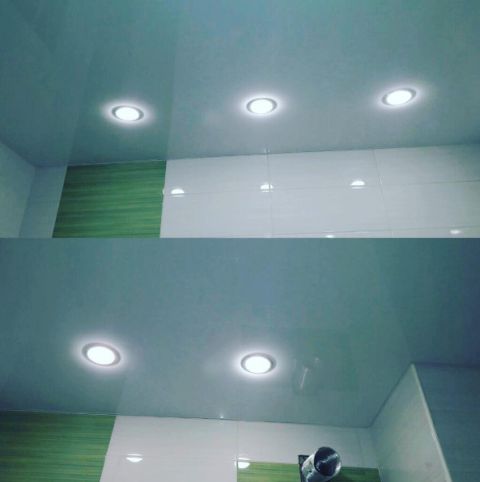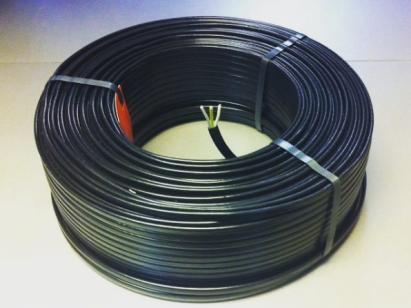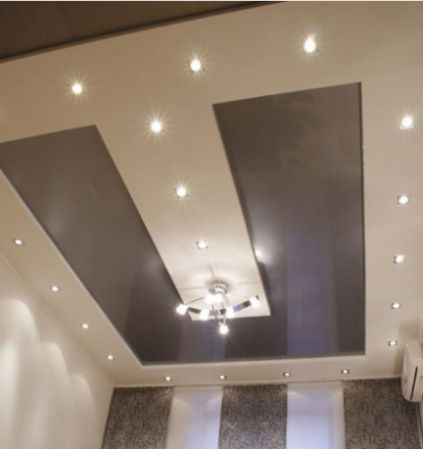Categories: Featured Articles » Electrician at home
Number of views: 21548
Comments on the article: 0
How to make wiring under a stretch ceiling
Stretch ceilings - one of the most popular options for finishing the ceiling in the house. One of the main advantages of suspended ceilings is the concealment of all irregularities, extraneous elements, including elements of home electrical wiring.
It is very important to understand that the question of how to make wiring under a stretch ceiling must be resolved before the stretch ceiling is mounted, since there are often situations when during the repair process the issue of replacing or revising an existing wiring is neglected.
Subsequently, improperly installed electrical wiring or electrical wiring, which is in unsatisfactory technical condition, makes itself felt and there is a need to repair it, which entails additional costs for dismantling and installing the suspended ceiling in a room or throughout the house.
In this article, we will consider in detail the question of how to correctly make wiring under a stretch ceiling in order to avoid negative consequences in the future.

First of all, it should be noted that the choice of a stretch ceiling as a finishing material gives a great advantage - the ability to install wiring in an open way on the ceiling. That is, in this case, the process of wiring is greatly simplified, since all the lines that were planned to be laid along the wall in the gates can be laid on the ceiling, saving not only time, but also the cost of installation work and wall decoration after gating and cable installation. This advantage must be taken into account when designing new wiring in order to simplify and reduce the cost of the process of replacing wiring in general.
Stretch ceiling wiring requirements
The basic requirements for wiring under suspended ceilings, however, as for wiring in the home as a whole, are reliability and safety of operation, both in terms of electrical safety, and in relation to fire safety.
First of all, it is necessary to correctly select all the structural elements of the electrical wiring, so that during the operation of household electrical appliances, elements of lighting devices, they work in the nominal mode, that is, do not overload and, accordingly, do not overheat.
Each of the wiring lines must be protected by a circuit breakerrated for such a rated current in order to protect all elements of the wiring from overheating or damage in case of possible overloads or short circuits.
To protect electrical wiring lines supplying the most dangerous electrical appliances with respect to electric shock, it is necessary to install residual current circuit breakers or combined protective devices - differential automata. RCD and difavtomat protect people from electric shock, as well as from fire electrical wiring in case of current leakage as a result of damage to the cable line or household appliances.
The electrical wiring as a whole must be equipped with a residual current device with a rated differential current of 100 mA, which, firstly, reserves the RCD of the outgoing lines, and secondly, performs a fire function, protecting against fire due to current leakage through the home wiring as a whole .
It is also necessary to install a circuit breaker at the input in the switchboard, which will reserve the circuit breakers of the outgoing wiring lines and in the event of a failure of one of the protective devices, will de-energize the wiring, preventing damage to a particular wiring line and, accordingly, the stretch ceiling under which this cable is laid.
To ensure fire safety under a stretch ceiling, it is necessary to lay a cable that has a non-combustible sheath. The most optimal option is the choice of cable type VVGng. Cable should lay in corrugated pipe, which will protect the suspended ceiling from damage in case of cable overheating during overload.

Also, the corrugation will act as an additional cable protection from the negative effects of moisture, which is important for rooms with a high level of humidity or for the apartment as a whole, if there is a possibility of flooding by neighbors in the apartment from above.
If the cable is to be laid on a combustible base, for example, on a wooden ceiling, the installed cable must be further protected by laying in a metal pipe or metal hose. The joints of pipes or metal hoses must be sealed and insulated from combustible surfaces with linings of non-combustible material.
Laying wiring in pipes gives an advantage not only in higher reliability, but also in easy access to the wiring cable, which, if necessary, can be easily replaced. But still, the installation of electrical wiring under a stretch ceiling, as well as around the house as a whole, should be carried out with the expectation of long-term operation, that is, it is necessary to mount a reliable electrical wiring in all aspects that will last for more than a dozen years, or at least until the next major apartment renovation or private home.
As for the electrical wiring under the suspended ceiling, the issue of the convenience of its maintenance is particularly important, in particular the easy accessibility of junction boxes and other electrical wiring elements in which periodic inspection and maintenance are necessary. That is, junction boxes, power supplies for low-voltage lighting, LED controllers and other devices must be mounted outside the suspended ceiling, so that, if necessary, they can be easily accessed for repair or replacement.

Separately, mention should be made of the wiring for powering the fixtures. Often, in order to save money, it is preferable to install a junction box on the ceiling, from which a branch of the wiring lines is supplied to power the lamps in the room. In this case, after installing the stretch ceiling, a junction box remains under it, in the event of damage which will not be accessible. Therefore, in this case, it is necessary to choose the most reliable method of connecting the conductors so that a reliable contact connection is ensured.
In this case, it is soldering, welding or crimping. It is better not to use terminal blocks under a stretch ceiling, since after installing a stretch ceiling there will be no access to them and, accordingly, if necessary, it will not be possible to assess their condition and replace them if contact reliability deteriorates.
In general, the most reliable option is to connect lamps without a junction box under a stretch ceiling. It is better to lay a larger amount of cable, but to connect the lamps either from each other or with the help of a junction box, but installed outside the stretch ceiling. In this case, it is better to spend more money, but to make reliable wiring, than to save a little, but in the future, if the wiring is damaged, be forced to dismantle the stretch ceiling, which will cost several times more and will cause a number of inconveniences.

Features of wiring under a stretch ceiling
When the wiring diagram of the apartment is carefully thought out, the personal preferences of the residents, the ease of operation of electrical appliances and most importantly their loads are taken into account, we proceed to draw up the wiring diagram. A wiring diagram is a diagram that clearly shows the location of all structural components of the wiring relative to building structures, communications and other elements of the home.
Do not neglect the compilation of this diagram, since without a well-thought out wiring diagram, the wiring will be chaotic, it will be possible to get confused and make a mistake, which will ultimately reduce the reliability of the wiring and the safety of its operation. On the other hand, wiring installed without a wiring diagram will be disordered, confusing, and therefore inconvenient to maintain.
When installing the cable, it is necessary to carry out its reliable fastening, to prevent sagging over the entire length.
It should also be mentioned about 12 V low-voltage lighting. Many say that low-voltage lighting is safer than 220 V lighting in all aspects, but this is not so. As for the voltage, in this case, low-voltage lighting can be considered conditionally safe. But in terms of fire safety, lighting at 12 V is more dangerous than at 220 V due to the fact that much greater currents flow in a 12 V network at equal power than at 220 V and, accordingly, there is a greater likelihood of cable overheating due to overload or contact failure connections, which may result in fire of the wire (cable).
See also at bgv.electricianexp.com
:
